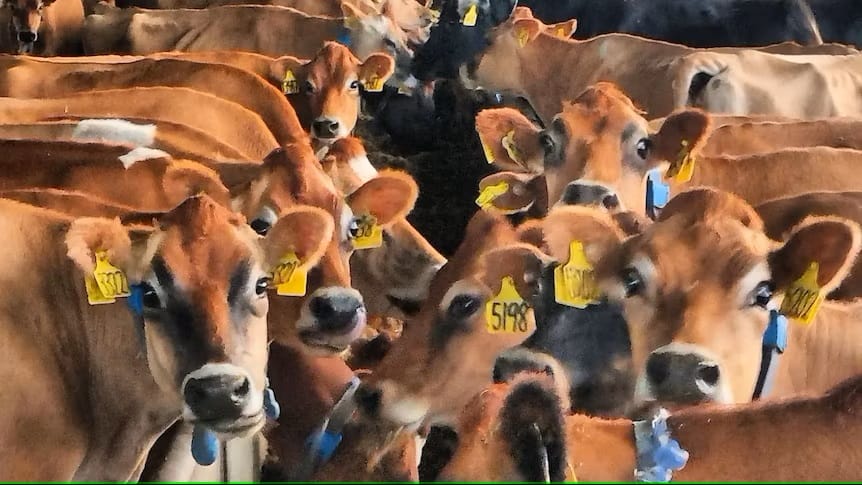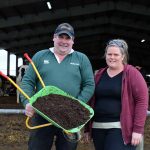
The price of a bottle of milk is expected to rise as major dairy processors continue to pay farmers more for their milk.
Key points:
- Dairy farmers are happy as processors compete for supplies
- Milk processors have increased payments to farmers by 3 cents per litre
- It is likely the consumer will continue to see retail milk prices rise
July is the start of the new milk season, and major processors are offering prices almost on par with last year’s record prices.
This has been welcomed by farmers who have faced large rises in costs, challenging weather conditions and years of flat milk values.
While farmers enjoy more in their hip pocket, there is likely to be more pain for shoppers, with recent inflation data showing dairy and related products soared 15 per year on year in June.
Battle for milk supplies
Competition for milk supplies among processors is likely to remain strong, with Dairy Australia revising its forecast for 2022–23 milk production downwards, anticipating a decrease of between 4 and 6 per cent over the course of the full season.
The national milk pool is down 5.3 per cent at the end of May compared to last year, and it has been trending down for the past two decades – dropping 1.035 billion litres in the 10 years to the end of the 2021-22 season.
As milk production falls, so has Australia’s export income – according to Dairy Australia figures, the export share of the national milk pool has dropped from 50 per cent two decades ago to one-third in recent years.
Large Australian-based processor Bega Cheese this week warned investors the high domestic prices being offered to farmers at a premium to global milk values was putting pressure on its business.
Bega Cheese executive officer Barry Irvin told an investor briefing on Tuesday they would write down $180-$280 million in assets, causing the share price to tank to 10-year lows.
Farmers sell their milk to processors to be used for fresh milk or processed as milk solids for use in cheese, yoghurt or baby formula.
Bega this week increased its opening milk price to $9.20 a kilogram of milk solids (kg/MS) on a weighted average, which is about 69 cents per litre to the farmer.
Big processors Fonterra and Saputo soon followed.
Small south-west Victorian ice cream company Bulla is leading the farm gate milk price pack after increasing its offer this week by 10c to $9.30-$9.90kg/MS.
Bowing out of dairy
Victoria is by far the largest milk production state, contributing about 64 per cent of the national milk pool, and its milk production has dropped 6.4 per cent from last year to the end of May.
The number of registered dairy farms in Victoria has been steadily decreasing over the past decade as herd sizes increase.
In Victoria, almost one-third of dairy farmers have exited the industry in the past decade, while in Tasmania 79 farmers left, down 18 per cent from 2011-12.
According to the same report, Victoria’s north-east and Gippsland region had the biggest milk production drop because of a surge in costs, lack of staff for farms, and the high returns of other livestock such as cattle, which meant some farmers were quitting dairy.
Jason and Casey Bermingham have decided to bow out of dairy while milk and land prices are high.
After almost 20 years at their property in Nambrok, Gippsland, east of Melbourne, the Berminghams wanted to find out what life outside of dairy was like.
“Because I’ve only ever known dairy farming, I didn’t know what else I could potentially do,” Mr Bermingham, who is training to become a nurse, said.
Mr Bermingham said the pressures and demands of the industry ultimately drove the decision to sell up.
“Just knowing that it’s a 24-hour-a-day, seven-day-a-week job,” he said.
“We were very lucky, we had really good staff, but it still is ultimately our own responsibility.”
Tasmania bucks the trend
The situation in Tasmania, which makes up about 10 per cent of the milk pool, is the opposite, with farmgate production up 3.2 per cent.
Over one-third of dairy farmers surveyed in the state reported expansion.
Tasmanian farmer Wayne Johnston diversified into dairy seven years ago and has just expanded his herd and built a new rotary dairy, which came online six weeks ago.
“We had a herd of 190 cows when we bought the dairy, we now have 260 and we hope to go to 350,” he said.
The long-time farmer got into dairy with the future in mind.
“The dairy industry at the moment is pretty good. I’ve been in vegies and livestock, and they’re down a bit at the moment,” he said.
“A few of my neighbours thought I was mad, prices were down when we started, but it’s just got better and better.”
He is confident his children will do well out of dairy when they take on the farm in the future.
“We are confident. It adds to our diversification,” he said.
“We made the right decision, buying and building. It just allows succession for our kids.”























